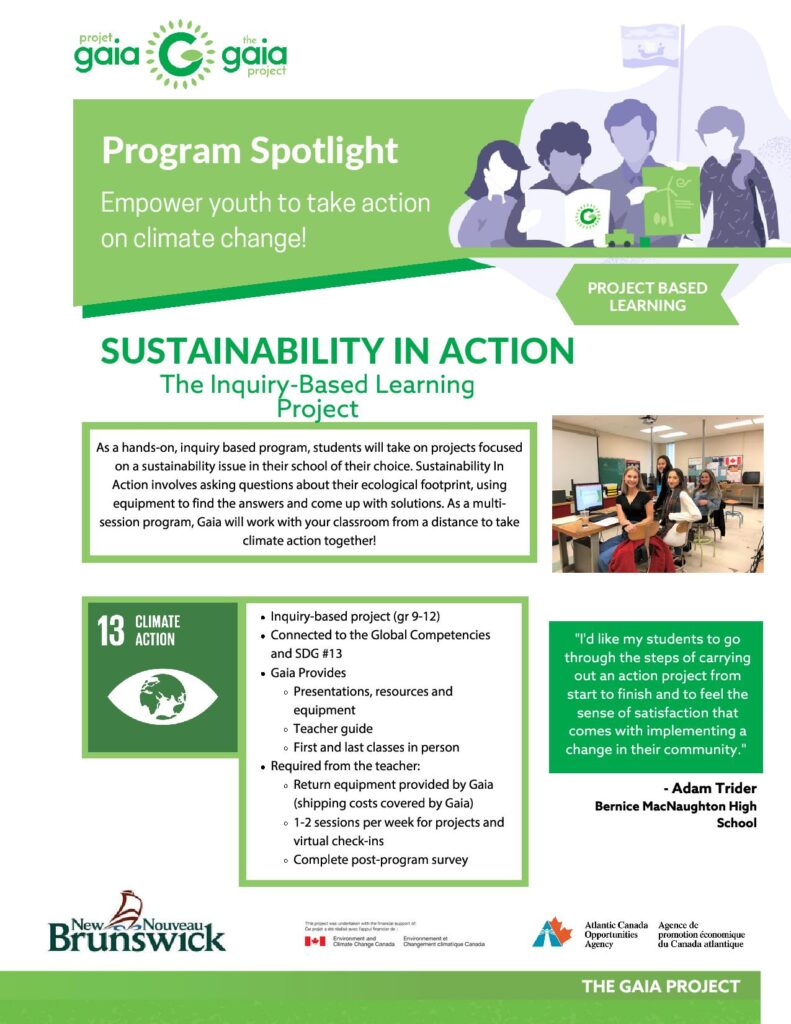Sustainable Action comes in All Forms
Sep 27, 2021
Are your students prepared for a life with climate change?
While over 75% of teachers believe climate change is an important topic to cover in school, a national study showcased that they find it hard to squeeze it amongst topics covered in math, science and social studies.
Also, climate change can bring up some uncomfortable feelings. Teachers may anticipate showing students images of skinny polar bears, natural disasters, and melting glaciers which could leave their students feeling anxious…
At The Gaia Project, we want to help. While teaching students about climate science is a part of what we do, we also take it a step further. We empower students to take climate action!
Through Sustainability in Action (SIA), our high school-based program, we work with your students on a hands-on project that will have a positive impact on your community. As teachers and educators, we believe it is important for youth to be knowledgeable on how to use their skills to contribute to change NOW.
In SIA, we encourage students to ask questions about the sustainability of their school or community. From there, we work to collect and analyze data and draw conclusions for a path forward. We offer guidance, equipment and, when possible, grant money to help see student ideas through. This program offers a unique opportunity that not only increases their understanding of how to take climate action but also how they can apply their unique skill set and passion to create change in whatever career path they choose. Using an inquiry-based approach The Gaia Project is here to help you enable discovery from start to finish!
There are over 21 NB schools already engaged in taking climate action with their students through the SIA program.
| CASE STUDY: ST STEPHEN HIGH SCHOOL |
| Let us start on Deer Island, one of the Fundy Islands in the Bay of Fundy. |
| How can a few high school students change water conservation in their entire school? After developing a research method, students at Deer Island collected data looking at the sinks in the bathrooms of the school. The group of students analyzed the data and identified which taps waste the most water in the school, as well as suggestions for alternative taps the school could install to help reduce the amount of waste. After a presentation to the school committee, a number of taps were purchased and installed, and a plan was developed to replace all the taps over time. |
| CASE STUDY: OROMOCTO HIGH SCHOOL |
| Now let us take a trip inland, where students from an Essential Skills class were challenged to come up with a design and layout of a perennial food forest for their campus. Students were introduced to many valuable skills and were proud to be a part of the project because they knew that the fruit they would plant would be harvested by many future generations of high schoolers at Oromocto High School. |
| Now that the first part of this project is complete, The Gaia Project hopes to continue work with OHS to add more elements and layers to the space as needed, while incorporating a broader understanding of how planting trees and increasing biodiversity plays a role in taking climate action. This project has inspired further action from students and teachers at this school. The second phase will include the installation of a compost system and a sitting area that could be used as an outdoor classroom. |
| CASE STUDY: BATHURST HIGH SCHOOL |
| Inspiring one child can change the way a whole community operates. It takes one person to look at a situation and think “how can we change this?”, like in the case of Bathurst High School, where one student named Kevin led an initiative that resulted in the creation of Bike to School Day. |
| The student did his research on active transportation, more specifically looking into why the students do not use their bicycles to get around. His survey led him to insightful responses about bike locking facilities and distance. This resulted in Ducks Unlimited and ADS-N sponsoring prizes to encourage students to bike to school and a new wall-mounted bike rack! One student who didn’t have a bike won one so they could participate in next year’s event. 42 students and 8 teachers biked to work during this event. |
| CASE STUDY: HAMPTON HIGH SCHOOL |
| The environmental impacts of our actions have an enormous ripple effect. Students have shown us that they have the tools to make decisions in an effective way, and some of the projects have not been about the action we take, but the actions we stop taking. |
| At Hampton High School a discussion about the impacts of Covid-19 on the pandemic led to a waste audit from five classrooms looking at soiled paper towels. Operational plans had students sanitizing their desks daily before class, but because of the disinfectant, the paper towels were not able to be composted. |
| Using the total number of classrooms in the school, they estimated that the school used 12.625 lbs of paper towels daily, adding up to 2380 lbs a year! Then they calculated the trees used and the additional financial costs. The class was able to look into their sustainability, change their actions by bringing in reusable and washable cloth, and encourage others to do the same. |
Through SIA, students learn that small actions can create large lasting impacts. Something even as simple as putting a sensor on a light, changing to more efficient and cost-effective light bulbs can make a difference!
| Working with TGP will be something that you will want to do every year. Just read some of the feedback we received from last year’s Sustainability in Action program: |
|
